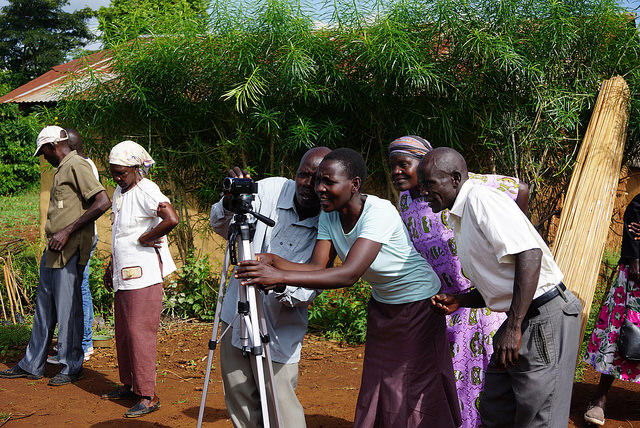An ecosystems approach to the SDGs in Africa: why we need to listen to farmers

To address all the SDG’s, we’re going to need to think like farmers. That means taking a systems approach that includes all kinds of agro-ecological farm systems. This mantra echoed through all the sessions at the Ecosystem Services Partnership Conference: Ecosystem Services for SDGs in Africa. Goals, 2, 5, 6, and 15 were in the spotlight, and to meet them, we have to think broadly and holistically.
That might not be what you expected to read, but CIAT research shows that farmers are the ultimate, great systems thinkers, and we need to tap into and build upon their vast network of knowledge to tackle the problems that face the ecosystems we are trying to protect and livelihoods we are aiming to support.
![]() Goal 2: End hunger, achieve food security and improved nutrition and promote sustainable agriculture.
Goal 2: End hunger, achieve food security and improved nutrition and promote sustainable agriculture.
![]() Goal 5: Achieve gender equality and empower all women and girls
Goal 5: Achieve gender equality and empower all women and girls
![]() Goal 6: Ensure availability and sustainable management of water and sanitation for all
Goal 6: Ensure availability and sustainable management of water and sanitation for all
![]() Goal 15: Sustainably manage forests, combat desertification, halt and reverse land degradation, halt biodiversity loss
Goal 15: Sustainably manage forests, combat desertification, halt and reverse land degradation, halt biodiversity loss
Through CIAT research using Participatory Video, farmers demonstrate their systems thinking at multiple levels. Within their farming systems they fully understand the interconnectedness of their daily farming activities. On a landscape level, farmers understand how their farm activities impact the wider environment and vice versa. Taking it to yet a broader level, farmers clearly articulate how poverty forces people to interact with their resources unsustainably.
Of course farmers are interested in improved yields, but CIAT and others at the ESP made a loud and clear call for broader indicators beyond just improved yields to incorporate the many other benefits provided by healthy ecosystems.
To better invest in and protect ecosystems, we need to understand the benefits they provide better. We need to understand the differentiated access users have to these benefits, which is exactly what CIAT and partners are doing with this new Participatory Mapping approach.
“We need a broader perspective. What should we preserve for future generations?”
John Gowdy
With this information, we can map and understand hotspots of ecosystem service provision and decline, areas of conflict over different resources, and differences in land use between men, women and youth. This helps to inform the range of realistic incentives that could sustain these vital ecosystems.
For example, in Lushoto District Tanzania, the participatory mapping results show the resources communities now have to buy because their natural supply is dwindling. If people spend money on resources they used to access for free, they have less money to invest in on-farm sustainable land management.
In Ntcheu District Malawi, the youth identified new plots along the river and wetland areas where they could still farm. This confirms that youth are under pressure to find scarce farmland and may need targeted land management support, or alternative sources of income generation, to conserve forest and wetland areas.
Who benefits and how?
These participatory approaches help identify who has a stake in land management changes. These changes impact access to resources or require new natural resource management practices. These practices need to be locally relevant and accepted by local communities to be sustainable.
Ultimately, we can identify areas to target investment in ecosystem protection. But to do it effectively, we need to listen to farmers – how, why and where they use ecosystem services. We need to understand where those services they demand might be endangered, and how they can be replenished, to ensure communities and protected landscapes can co-exist.
Call to action:
- More investment is needed in participatory approaches to incorporate farmers’ voices and needs as regards their interaction with the landscape.
- Out-scaling mapping initiatives can help decision makers and investors target interventions and sustainable land management options that help communities manage dwindling resources and identify alternative incomes for healthier ecosystems.
- Models of intervention need to be based on the realistic needs and demands of farmers as well as the interests of investors and decision makers to be sustainable.
Acknowledgments:
This research was supported by the CGIAR Research Program on Water, Land and Ecosystems, BMZ (AGORA) and EC-IFAD.



